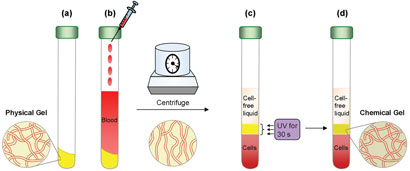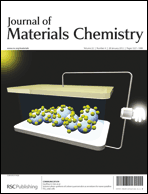US scientists have developed a separator gel that can form a permanent barrier between blood components when exposed to ultraviolet (UV) light, to keep cells and plasma apart for medical analysis.

(a) The gel is placed at the bottom of a tube. (b) A blood sample is added. The tube is then placed in a centrifuge, where the gel is liquefied. Owing to its density, the liquefied gel flows to a position between the blood cells and plasma. (c) When centrifugation is stopped, the network is re-established and the gel recovers its solid character, forming a weak barrier between the blood layers. (d) The gel layer is irradiated with a UV lamp, converting the material into a hard, chemically crosslinked network, resulting in a rigid and permanent barrier
Blood tests typically only use the cell-free fraction of whole blood (serum or plasma), and it is common practice within blood sample tubes for these liquids to be separated from the blood cells by a separator gel. Separator gels are designed to reversibly liquefy during centrifugation. They have a density between that of the cells and solution components, so that they separate the components by flowing to a position between the layers during centrifugation. Following centrifugation, the gels stop flowing and remain as a soft barrier between the layers. However, the soft barrier can cause contamination, and leaks between the components and the gel can occur during sample transportation and storage. Interested to know more? Read the full article in Chemistry World here…
Read the paper from Journal of Materials Chemistry:
A new method for centrifugal separation of blood components: Creating a rigid barrier between density-stratified layers using a UV-curable thixotropic gel
Kunshan Sun, Hyuntaek Oh, Jane F. Emerson and Srinivasa R. Raghavan
J. Mater. Chem., 2012, Advance Article
DOI: 10.1039/C2JM14818H
To keep up-to-date with all the latest research, sign up for the journal’s e-alerts or RSS feeds or follow Journal of Materials Chemistry on Twitter













 Scientists at Tongji University, Shanghai, China, have developed a method of creating patterns on photonic paper that are only visible when the paper is wet. The siloxane-containing photonic paper is fabricated by using lithography to create a contrast of crosslinking or degree of hydrophobization. When the invisible prints are soaked in water for several minutes, the small difference in reflection wavelength (λ) between the pattern and the background is significantly amplified due to their different swelling speeds, which leads to a visible image. The process is fully reversible and soaking and drying will repeat the cycle of showing and hiding the patterns.
Scientists at Tongji University, Shanghai, China, have developed a method of creating patterns on photonic paper that are only visible when the paper is wet. The siloxane-containing photonic paper is fabricated by using lithography to create a contrast of crosslinking or degree of hydrophobization. When the invisible prints are soaked in water for several minutes, the small difference in reflection wavelength (λ) between the pattern and the background is significantly amplified due to their different swelling speeds, which leads to a visible image. The process is fully reversible and soaking and drying will repeat the cycle of showing and hiding the patterns.

 Combining metallic nanoparticles with host materials whose dielectric properties can be tuned by means of an external control is one route to create “active plasmonics”. In this hot article a soft-matter periodic structure made from a composite mixture of cholesteric liquid crystals and Au nanoparticles is reported. The cholesteric liquid crystals act as a “host fluid” whose refractive index can be varied in a broad range by using external electric fields and temperature variations. This has a strong influence on the position of the plasmonic absorption peak of the nanoparticles.
Combining metallic nanoparticles with host materials whose dielectric properties can be tuned by means of an external control is one route to create “active plasmonics”. In this hot article a soft-matter periodic structure made from a composite mixture of cholesteric liquid crystals and Au nanoparticles is reported. The cholesteric liquid crystals act as a “host fluid” whose refractive index can be varied in a broad range by using external electric fields and temperature variations. This has a strong influence on the position of the plasmonic absorption peak of the nanoparticles.